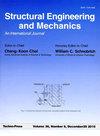用声发射和DIC技术对钢和玻璃钢加固梁进行无损评价
IF 3
4区 工程技术
Q2 ENGINEERING, CIVIL
引用次数: 0
摘要
本文采用声发射(AE)和数字图像相关(DIC)的无损技术,研究了钢和玻璃纤维增强聚合物(GFRP)钢筋混凝土梁在四点弯曲下的广泛变化的力学性能和行为。分别对0.33%、0.52%和1.11%受拉钢筋的混凝土梁进行了室内试验。结果表明,在两种情况下,极限承载力均随受拉配筋的增加而增加。此外,声发射波形参数的振幅和声发射命中次数成功关联并获取了钢筋和玻璃钢筋混凝土梁开裂起裂和破坏进展的发散机制。与钢- rc梁相比,GFRP-RC梁的声发射活性约高20- 30%。这主要是由于GFRP筋的弹性模量较低,与钢- rc梁相比,其延性和挠度要大得多。此外,基于DIC的声发射XY事件图和纵向应变分布图可以在线实时可视化地分别显示声发射活动和应变的变化过程,有效地描述了钢- rc和GFRP-RC梁在不同加载阶段的裂缝演变和发展过程,与实际梁中观察到的微观和宏观裂缝非常吻合。本文章由计算机程序翻译,如有差异,请以英文原文为准。
Non-destructive evaluation of steel and GFRP reinforced beams using AE and DIC techniques
The paper presents an investigation of the widely varying mechanical performance and behaviour of steel and Glass Fibre Reinforced Polymer (GFRP) reinforced concrete beams using non-destructive techniques of Acoustic Emission (AE) and Digital Image Correlation (DIC) under four-point bending. Laboratory experiments are performed on both differently reinforced concrete beams with 0.33%, 0.52% and 1.11% of tension reinforcement against balanced section. The results show that the ultimate load-carrying capacity increases with an increase in tensile reinforcement in both cases. In addition to that, AE waveform parameters of amplitude and number of AE hits successfully correlates and picks up the divergent mechanism of cracking initiation and progression of failure in steel reinforced and GFRP reinforced concrete beams. AE activity is about 20- 30% more in GFRP-RC beams as compared to steel-RC beams. It was primarily due to the lower modulus of elasticity of GFRP bars leading to much larger ductility and deflections as compared to steel-RC beams. Furthermore, AE XY event plots and longitudinal strain profiles using DIC gives an online and real-time visual display of progressive AE activity and strains respectively to efficaciously depict the crack evolution and their advancement in steel-RC and GFRP-RC beams which show a close matching with the micro-and macro-cracks visually observed in the actual beams at various stages of loading.
求助全文
通过发布文献求助,成功后即可免费获取论文全文。
去求助
来源期刊

Structural Engineering and Mechanics
工程技术-工程:机械
CiteScore
3.80
自引率
18.20%
发文量
0
审稿时长
11 months
期刊介绍:
The STRUCTURAL ENGINEERING AND MECHANICS, An International Journal, aims at: providing a major publication channel for structural engineering, wider distribution at more affordable subscription rates; faster reviewing and publication for manuscripts submitted; and a broad scope for wider participation.
The main subject of the Journal is structural engineering concerned with aspects of mechanics. Areas covered by the Journal include:
- Structural Mechanics
- Design of Civil, Building and Mechanical Structures
- Structural Optimization and Controls
- Structural Safety and Reliability
- New Structural Materials and Applications
- Effects of Wind, Earthquake and Wave Loadings on Structures
- Fluid-Structure and Soil-Structure Interactions
- AI Application and Expert Systems in Structural Engineering. Submission of papers from practicing engineers is particularly encouraged.
 求助内容:
求助内容: 应助结果提醒方式:
应助结果提醒方式:


